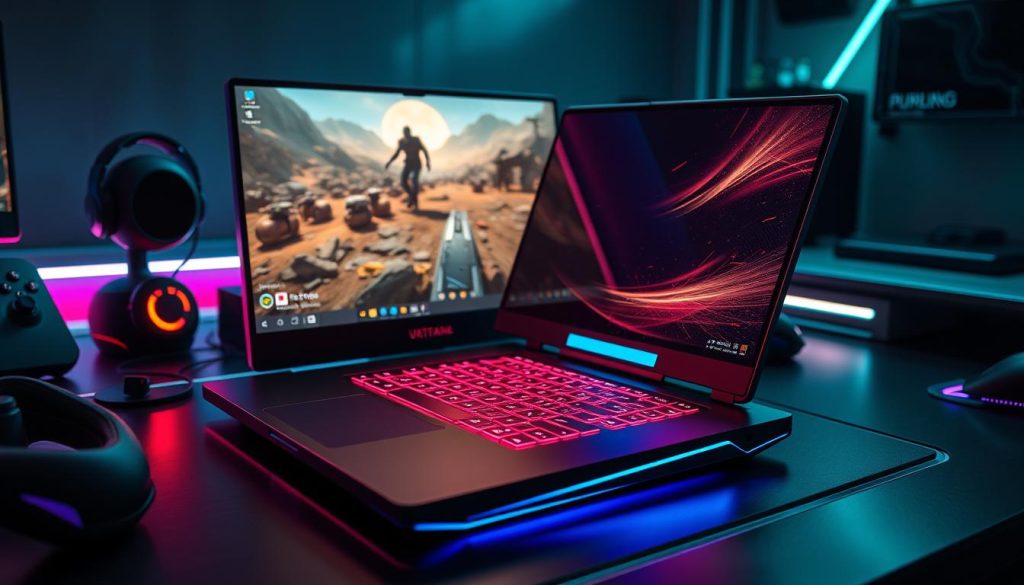Did you know top gaming laptops can cost over $3,000 with Nvidia’s GeForce RTX 4080 or 4090 GPUs? Knowing what makes the best gaming laptops can help you avoid poor performance or spending too much. Whether you want a basic model or the latest tech, understanding what to look for is key.
Gaming laptops let you play games anywhere, packing everything you need into one portable device. The GPU, CPU, RAM, storage, and display are all important for performance. A strong GPU is crucial for great game performance and can’t be changed later. RAM and storage can be updated, though.
Also, the display’s resolution, refresh rate, and keyboard design matter a lot for gaming. But, remember, these laptops use a lot of power, so their batteries don’t last as long.
Key Takeaways
- High-end gaming laptops equipped with Nvidia’s top-tier GPUs can start around $2,000 and exceed $3,000.
- The GPU is the core driver of game performance and is non-upgradable in laptops.
- RAM and storage can often be upgraded later, with 16GB being the recommended size for gaming.
- Display resolution should be at least 1920 x 1080, with considerations for refresh rate and panel technology.
- Keyboard quality, including key travel and actuation force, significantly impacts the gaming experience.
Graphics Card (GPU): The Heart of Performance
Choosing the right graphics card GPU is key for great gaming laptop performance. Whether you’re into casual or virtual reality gaming, the GPU is what makes high-performance laptops tick. Nvidia GeForce RTX and AMD Radeon RX series lead the market, each with their own strengths and weaknesses.
Entry-Level Gaming
For beginners or those on a tight budget, entry-level gaming laptops are a good start. They come with GPUs like the Nvidia GeForce RTX 4050 or older AMD Radeon models. These GPUs handle simpler games well. Prices range from $800 to $1,100, making them a budget-friendly option.
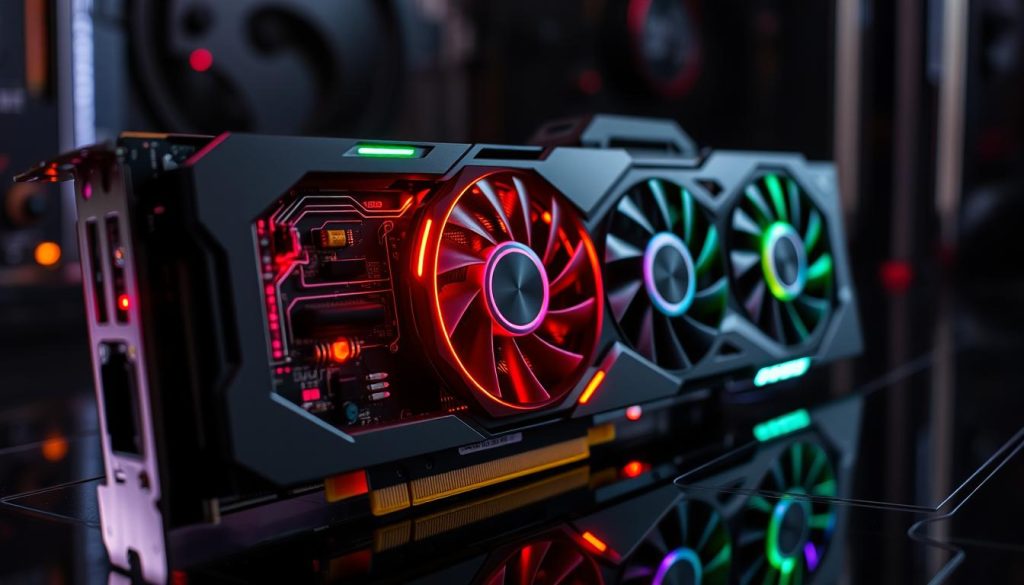
Mainstream Gaming
Mainstream gaming laptops offer a good mix of price and performance. They feature GPUs such as the Nvidia GeForce RTX 4060 and RTX 4070. These GPUs support modern games at higher settings for a better gaming experience. Prices are between $1,100 to $1,500, providing great value.
High-End Gaming and VR
For top gaming and virtual reality, high-end gaming laptops are your best bet. They come with powerful GPUs like the Nvidia GeForce RTX 4080 or 4090. These laptops can handle 4K gaming and VR easily. Prices start at $2,000 and can go over $3,000, but you get unmatched performance and future-proof tech.
It’s also important to consider the GPU architecture. AMD’s RDNA and Nvidia’s Turing have different features and performance levels. Plus, the cooling system in gaming laptops is key to avoid overheating and slowdowns.
Here’s a table to help you pick the right GPU:
| Gaming Category | Recommended GPU | Performance | Price Range |
|---|---|---|---|
| Entry-Level | Nvidia GeForce RTX 4050, AMD Radeon (older models) | Basic gaming, lower settings | $800 – $1,100 |
| Mainstream | Nvidia GeForce RTX 4060, RTX 4070 | High settings, smooth frame rates | $1,100 – $1,500 |
| High-End | Nvidia GeForce RTX 4080, RTX 4090 | 4K gaming, VR-ready | $2,000 – $3,000+ |
Processor (CPU): Powering Your Gameplay
When you look at gaming laptops, the processor (CPU) is crucial. It can greatly affect your gaming fun. Modern games use multi-core processors for smooth play. The Intel Core i9 is top-notch, but knowing about different specs helps you choose the right one.
Core Count and Thread Management
Having more cores and good thread management is key for gaming laptops. Processors like the Intel Core i9 handle many tasks at once well. This means you can play games and use apps together without lag.
A laptop with an Intel Core i9 or a top AMD Ryzen will give you an edge in gaming and multitasking.
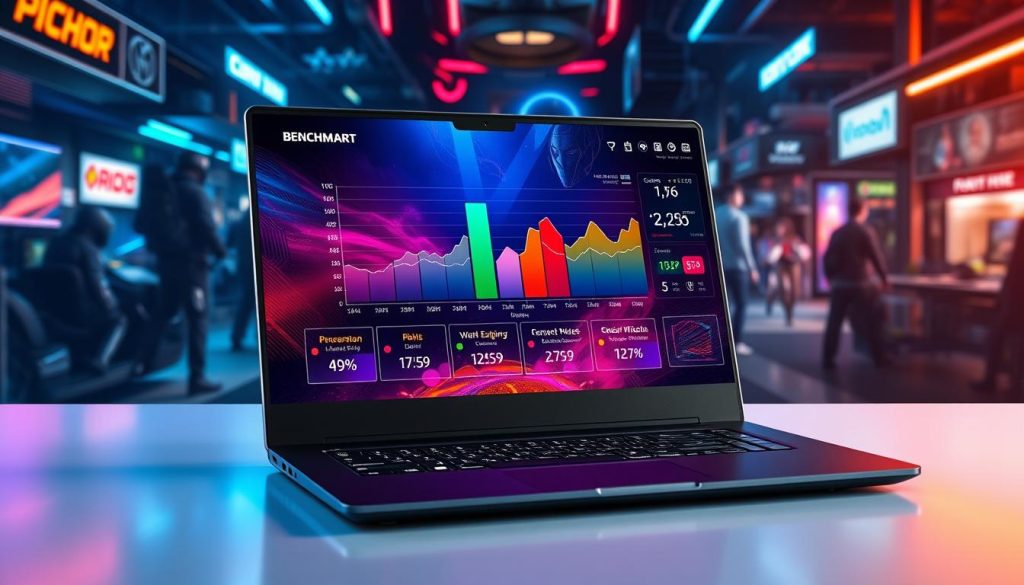
Clock Speed Considerations
Clock speed is how fast a CPU does tasks, which is vital for gaming laptops. Faster clock speeds mean better performance in games that use one thread. When checking out laptops, look for ones with turbo boosts for extra speed in tough games.
Overclocking Options
For gamers wanting more power, overclocking is a good choice. It means running your CPU faster than usual. Laptops with Intel Core i9 processors are often easy to overclock. But, make sure your laptop can cool down well, since it will get hotter with more speed.
The processor you pick will greatly affect your gaming fun. Whether you want a top Intel Core i9 or another processor, knowing these details will help you get the best performance from your laptop.
RAM: The Unsung Hero of Performance
RAM is key for smooth multitasking and quick gameplay in gaming laptops. Most start with 8GB RAM, but 16GB is better for modern games and multitasking. Laptops like the Zephyrus G14 and Flow X13 are slim yet powerful, perfect for gaming on the go.
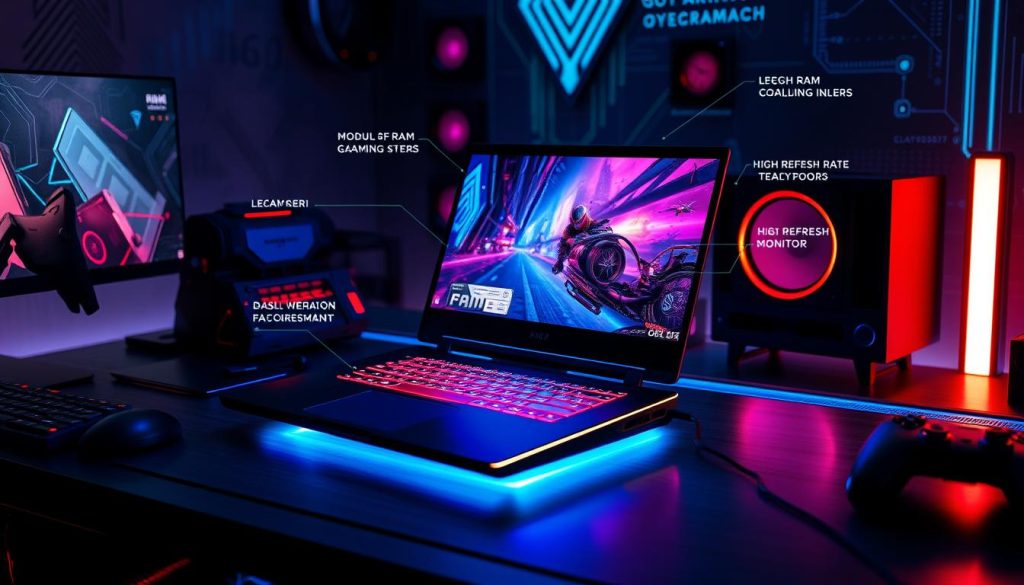
Many gaming laptops let you upgrade RAM, starting with less and adding more as needed. The Strix SCAR 16 and Strix SCAR 18 are great examples. They have powerful screens and easy RAM access.
Here are some important RAM stats for gaming:
| Model | RAM Capacity | Performance Impact | Market Share (%) |
|---|---|---|---|
| Zephyrus G14 | 16GB – 32GB | High Efficiency | 14.5 |
| Flow X13 | 8GB – 16GB | Moderate to High | 12.3 |
| Strix SCAR 18 | 32GB – 64GB | Maximum Performance | 18.9 |
Crucial offers reliable RAM for specific models, making upgrades easy and effective. DDR5 RAM is great for gaming and heavy tasks because it’s faster and more efficient.
The Strix SCAR 16 and others offer up to 175W GPU power with cooling systems. They’re perfect for HDR gaming and RAM upgrades make them even better.
Upgrading RAM can turn a slow gaming laptop into a fast one. With the right tools and care, you can boost performance. This makes gaming more immersive and fun.
Storage Solutions: SSD vs. HDD
Choosing between SSD storage, HDD for gaming, and hybrid solutions affects your gaming laptop’s performance and experience. The best storage depends on your laptop’s specs for speed and capacity.
Advantages of SSD
SSDs are great for gamers. They make games load faster, ensuring smoother play and better graphics. NVMe M.2 SSDs are up to 10 times faster than old SATA drives, with Gen5 tech offering speeds 22 times faster.
SSDs are reliable, durable, and use less energy. They run cooler because they have no moving parts, which lowers overheating risks and extends device life. Their fast read and write speeds improve system speed and data access.
The Role of HDD in Gaming Laptops
Even with SSDs’ speed, HDDs are key for gaming laptops. They’re cheaper and hold more data. A 2TB HDD costs about $60, while a similar SSD is $90.
HDDs are good for storing lots of games and files. But, they’re slower and use more energy than SSDs, affecting performance. Many gamers use both internal and external HDDs, from 500GB to 2TB, to meet their storage needs.
Hybrid Storage Solutions
Hybrid solutions combine SSD and HDD for gaming. They use SSDs for the OS and key apps for quick boot times and fast data access. HDDs store games and files that don’t need quick loading.
These setups let gamers tailor their laptops to their needs, offering lots of storage and good performance. Many laptops can be upgraded to add more storage later, letting users expand as needed.
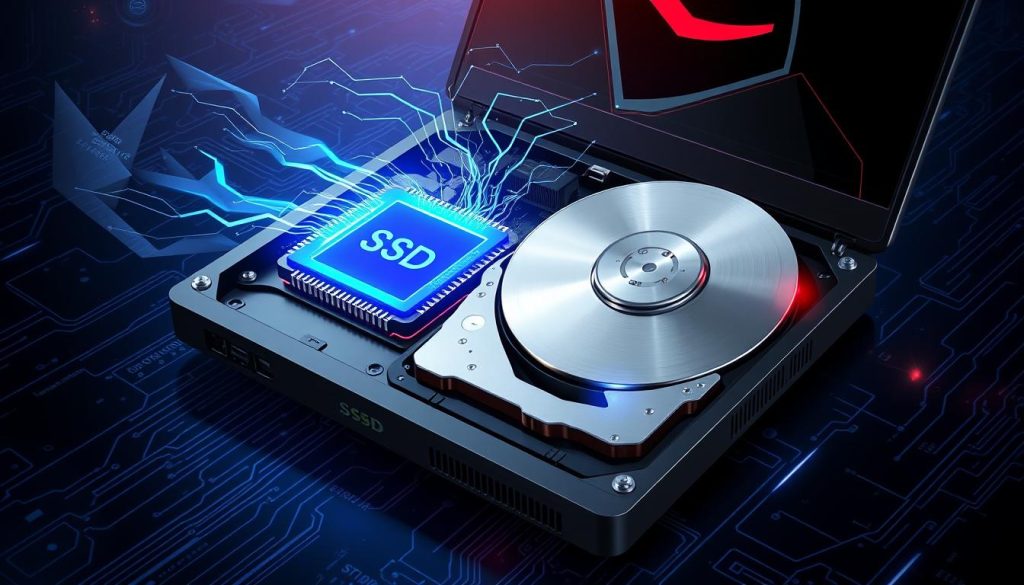
| Aspect | SSD | HDD | Hybrid |
|---|---|---|---|
| Speed | Up to 22 times faster than SATA | Slower | Optimized (SSD for performance, HDD for capacity) |
| Capacity | Up to 8TB | Larger storage at a lower cost | Balanced, with SSD and HDD |
| Cost | More expensive | More affordable | Moderate, with varying costs |
| Durability | More durable (no moving parts) | Less durable (moving parts) | Depends on individual parts |
| Energy Efficiency | More energy-efficient | Less energy-efficient | Depends on usage |
Comparing Gaming Laptops: What to Look For in Performance
When comparing gaming laptops: what to look for in performance, it’s key to balance the components for your gaming needs and budget. Look at the GPU, CPU, RAM, and storage to make sure the laptop can run the games you want at the settings you prefer. Let’s look at some important points:
Balancing Components for Optimal Performance
For the best gaming performance, you need well-balanced components. The MSI Katana 15 is great for 1080p gaming at $999, perfect for those on a budget. The Lenovo Legion Pro 5i (Gen 8) is the top pick under $1,500 for esports, offering smooth gaming. Think about these points carefully:
- GPU: The GPU is crucial, with models like the Nvidia GeForce RTX 4090 in the MSI Titan 18 HX offering top graphics power.
- CPU: A good CPU is vital for gameplay and multitasking. Look for high core counts and speeds for better performance.
- RAM: More RAM means smoother multitasking and gameplay. The MSI Titan 18 HX has 128 GB RAM for heavy use.
- Storage: SSDs are faster than HDDs. The MSI Titan 18 HX has a 4 TB SSD for lots of storage.
- Display: Screen size and refresh rate matter. The Asus TUF Gaming A14 has a 14-inch screen, while the MSI Titan 18 HX has an 18-inch 4K display.
Understanding Spec Sheets
It’s important to read and understand spec sheets when comparing gaming laptops. These sheets give detailed info on components and help you see if a laptop fits your gaming needs. For example, the Asus ROG Strix G16 has a spec sheet that shows its processor speed, RAM, and display resolution. This helps buyers make a good choice:
| Laptop Model | Price | Screen Size | Resolution | GPU | CPU | RAM | Storage |
|---|---|---|---|---|---|---|---|
| MSI Titan 18 HX | $4,799.99 | 18-inch | 4K | Nvidia GeForce RTX 4090 | Intel Core i9 | 128 GB | 4 TB SSD |
| Asus TUF Gaming A14 | $1,499.99 | 14-inch | 1440p | Nvidia GeForce RTX 4060 | AMD Ryzen 9 | 16 GB | 1 TB SSD |
| Acer Nitro 16 | $999.99 | 16-inch | 1080p | Nvidia GeForce RTX 3050 | Intel Core i5 | 8 GB | 512 GB SSD |
When looking at gaming laptop performance, don’t overlook any component. The balance of GPU, CPU, RAM, storage, and display specs affects your gaming experience. Picking the right mix for your gaming style and budget is key to finding the best gaming laptop.
Display Quality: Resolution, Refresh Rate, and Beyond
Choosing a gaming laptop means looking at display quality closely. It’s key to your gaming fun. You should know about size, resolution, refresh rate, and panel types to pick the best one.
Size and Resolution
The size and resolution of a gaming laptop’s display matter a lot. Sizes range from 14 to 18 inches. You’ll find resolutions from Full HD (1920 x 1080) to 4K (3840 x 2160).
High-resolution displays make games look clearer and more detailed. If you want sharper images, consider QHD (2560 x 1440) or UHD/4K. But, these need a strong GPU, which might lower the refresh rate.
Refresh Rate
The refresh rate, in Hertz (Hz), is key for smooth gaming visuals. Most laptops have a 60Hz refresh rate. But, gaming laptops can go up to 120Hz or even 480Hz.
Higher refresh rates are great for fast games. They reduce motion blur and make actions smoother. For example, a 240Hz or 480Hz screen makes quick movements look fluid.
Panel Types
Panel technology affects display quality too. IPS panels are known for their color accuracy and wide viewing angles. OLED panels offer vibrant colors and deep blacks for a deeper experience.
But, touch screens on gaming laptops might cut battery life and add unwanted shine. Be careful with these features.
So, balancing resolution, refresh rate, and panel type is key for a great gaming laptop. By focusing on these, gamers can get a laptop that suits their visual needs.
Keyboard and Input: More Than Just Looks
When picking a gaming laptop, the keyboard and input features are key. They affect how well you play games. Key aspects include key travel, actuation force, backlighting options, and programmable macro keys.
Key Travel and Actuation Force
Key travel and actuation force affect typing comfort and how well you play. The best key travel is over 1.5mm, with an actuation force of 65-70 grams. This setup helps reduce hand fatigue during long gaming sessions and makes keystrokes quicker and more precise.
Backlighting Options
Gaming laptops offer various backlighting options to improve looks and usability. You can choose from single-color to dynamic per-key RGB setups. This lets you match your keyboard to your style or game. It also helps in low-light settings.
Macro Keys and Customization
Programmable macro keys are a must for gamers needing quick complex commands. With customization software, you can set these keys for in-game actions, macros, or everyday tasks. High-end laptops often have mechanical keyboards for gaming, offering tactile feedback and lasting durability.
Here’s a look at some popular gaming laptops and their keyboard features:
| Model | Typing Quality Rating | Backlighting | Macro Key Customization |
|---|---|---|---|
| Dell Alienware m18 R2 (2024) | 9.0 | Per-key RGB | Yes |
| Lenovo Legion Pro 5 Gen 8 16 (2023) | 8.0 | Zonal RGB | Yes |
| ASUS TUF Gaming A16 Advantage Edition (2023) | 7.5 | Single-color | No |
| Lenovo LOQ 15 (2023) | 7.2 | Zonal RGB | No |
| Acer Chromebook 516 GE (2022) | 7.0 | Single-color | No |
For both casual and competitive gamers, knowing about these keyboard features can boost your gaming. Choosing mechanical keyboards and programmable macro keys can give you an edge and make every keypress count.
Battery Life: Balancing Power and Portability
When looking at gaming laptops, gaming laptop battery life is key. Gamers need a mix of power and portability, especially when they’re always on the move. Different gaming laptops have various battery lives, depending on their setup and how they’re used.
High-end GPUs and processors boost gaming but eat up a lot of energy. This means many gaming laptops don’t last as long as regular ones. Some can go up to 8 hours on one charge, but others need to be plugged in often, especially when gaming a lot.
| Type | Recommended CPU | Recommended GPU | RAM | Battery Life |
|---|---|---|---|---|
| Entry-Level | Intel® Core™ i5 / AMD Ryzen 5 | GTX 1650 / RX 560 | 8GB | Up to 5 hours |
| Mid-Range | Intel® Core™ i7 / AMD Ryzen™ 7 | GTX 1660 Ti / RTX 2060 | 16GB | Up to 7 hours |
| High-End | Intel® Core™ i9 / AMD Ryzen™ 9 | RTX 3080 | 16GB+ | Up to 8 hours |
Portable gaming laptops like the Razer Blade 14 (2023) aim for long battery life without losing performance. They’re perfect for gamers who want power and to be mobile. These laptops can last from 12 to 20 hours or more, while gaming laptops with more powerful hardware have shorter battery lives.
Lenovo’s Legion series and HP gaming laptops offer various options for different needs and budgets. For example, the Lenovo Legion Pro 5 and 7i have different performance and battery life options. This way, gamers can pick the right balance for their gaming style.
So, finding the best gaming laptop battery life means thinking about how much you’ll be moving around and how much gaming you’ll do. Picking the right balance is key for a great gaming experience.
Cooling System: Maintaining Optimal Performance
A gaming laptop’s performance depends a lot on its cooling system. It’s key to have efficient fans and vents to keep the heat down and stop thermal throttling. Some laptops use liquid cooling or vapor chambers for better heat handling. Even slim laptops can cool well now, thanks to new tech, without being too loud or heavy.
When picking a gaming laptop, think about how well it stays cool. A well-cooled laptop will perform well even when you’re gaming for hours.
Fan and Ventilation Design
How a gaming laptop cools down is very important. Brands like Razer and Asus focus on placing fans right and improving airflow. Some laptops have many fans to cool better. For example, Lenovo’s gaming laptops use dual fans with smart aerodynamics to cool quietly and effectively.
Liquid Cooling and Other Advanced Methods
Liquid cooling is getting popular in high-end laptops. It uses liquid to take heat away from important parts quietly.
- Vapor chamber cooling: In top models, vapor chambers keep temperatures steady, which is key for GPUs and processors during heavy gaming.
- Hybrid cooling solutions: These mix heat pipes and liquid cooling for balanced and efficient cooling in laptops.
For gamers who play for a long time, these cooling systems are crucial. They make sure the laptop performs well without any breaks.
Conclusion
Choosing the right gaming laptop means knowing what to look for in performance. Key factors include the GPU, CPU, RAM, storage, display, keyboard, battery life, and cooling. A strong graphics card from Nvidia or AMD, paired with a powerful processor like the Intel Core i7 or AMD Ryzen 7, ensures smooth gameplay.
Memory is key; 16GB of RAM or more is best for top performance. Choosing SSD storage over HDD cuts down loading times, making games run smoother. A high-resolution display with fast refresh rates (at least 144Hz) and accurate color is crucial for detailed visuals.
A comfortable, responsive keyboard with backlighting and an accurate trackpad makes gaming easier and more convenient. Battery life is a challenge, but gaming laptops with good battery life and cooling systems like dual fans and heat-pipes help.
Brands like Alienware (Dell), Asus ROG, Acer Predator, HP Omen, Gigabyte Aorus, Lenovo Legion, and MSI offer many options. By comparing specs and matching them with your gaming needs, you can find a laptop that enhances your gaming.
FAQ
What are the most vital components to consider when selecting a gaming laptop?
Key components include the GPU, CPU, RAM, storage, display quality, keyboard, battery life, and cooling system. These elements affect the gaming experience and performance.
Why is the GPU so important in gaming laptops?
The GPU is key because it boosts game performance. It affects graphics quality and frame rate. For top performance, choose Nvidia GeForce RTX or AMD Radeon RX series.
How does the CPU impact gaming performance?
The CPU manages threads and cores for smooth gameplay. Multi-core processors with high speeds are great for heavy gaming and multitasking. CPUs like the Intel Core i9 offer extra performance.
How much RAM do I need for a gaming laptop?
You need at least 8GB of RAM for basic gaming. But 16GB is better for smooth gaming and multitasking. Many laptops let you upgrade RAM as needed.
Should I choose an SSD or an HDD for my gaming laptop?
SSDs are faster, reducing game loading times and improving performance. HDDs offer more storage. Many laptops use both SSD and HDD for speed and capacity.
What display factors are important in a gaming laptop?
Key display factors are size, resolution, refresh rate, and panel technology. Aim for a resolution of 1920 x 1080 and a high refresh rate for smooth visuals. OLED and high refresh rate panels improve visual quality.
What should I look for in a gaming laptop keyboard?
Look for key travel over 1.5mm, actuation force, macro keys, and backlighting options. Macro keys let you customize commands. Per-key RGB backlighting adds style and function.
How does battery life affect gaming laptops?
Battery life is short due to gaming hardware’s high power use. Some laptops last up to 8 hours, but most need a power supply for best performance. Consider battery life based on your needs and usage.
Why is the cooling system critical in gaming laptops?
A good cooling system prevents overheating and keeps performance steady during long gaming. Advanced cooling like liquid cooling helps with heat. Check thermal performance when choosing a laptop.


